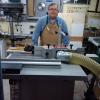Is there any advantage to having a variable speed bench grinder?
Obviously, slower speed means less heat generation but longer times to grind. With the variable speed I could turn it up for jobs requiring more removal of metal. I guess the real question is how often it may be advantageous to slow it below the 3500 rpm of the fixed speed ac grinder.
I’ve got a Tormek, but need a grinder that will handle reshaping as well as lawn mower blades. I have an opportunity to pick up an 8” variable dc grinder that is capable of adjusting speed from 400-4000 rpm. I expect to grind primarily plane blades, chisels, carving tools, occasionally carving tools, and cutters for a metal lathe. I’ll do final dressing on the Tormek or on ceramic bench stones. My main use for the tools will be to establish a clean bevel edge or reshape a tool, and to sharpen metal lathe tools and mower blades.




 Reply With Quote
Reply With Quote







